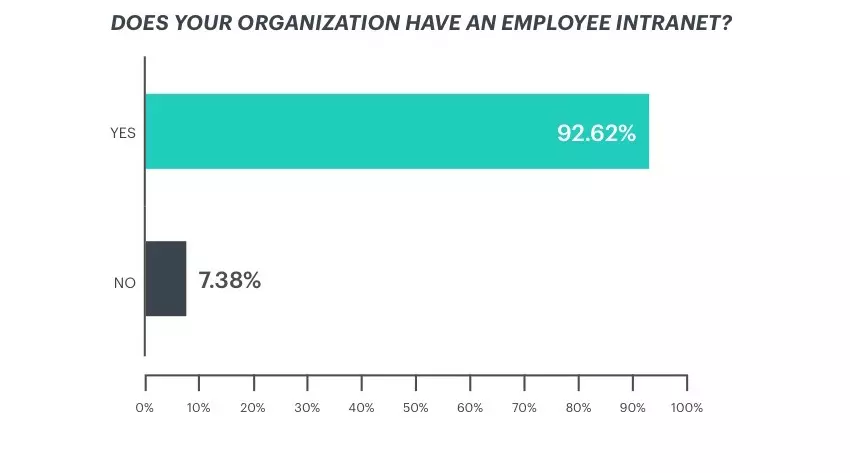“What are the benefits of an intranet?” It’s a question intranet practitioners are asked constantly but people would be lying if they didn’t admit that intranet benefits are somewhat difficult to convey, let alone show concrete intranet ROI.
In Simpplr Research’s State of the Intranet 2019 Survey, we found that over 90% of organizations maintain an intranet. Clearly, intranets are valuable.

But the same survey found that more than half of organizations struggle to understand the employee intranet’s purpose. More than half of organizations admit that they have an employee intranet without a defined purpose.
So, what are the benefits or advantages of an intranet?
The answer depends on what problems organizations are trying to solve. Below are various approaches organizations have used to articulate their intranet’s benefits:
- Intranet Benefit #1: Improve employee engagement
- Intranet Benefit #2: Improve employee productivity
- Intranet Benefit #3: Connect distributed employees
- Intranet Benefit #4: Improve change management communications
- Intranet Benefit #5: Drive stronger intranet usage and adoption when the status quo isn’t working.
Intranet Benefit #1: Improve employee engagement
A lot of employee engagement research is available (both externally and through Simpplr Research) that shows why important employee engagement matters. Most of us are familiar with the broad-brush Gallop statistics: 70% of U.S. employees are unengaged with their company year after year, resulting in unproductivity that costs companies billions of dollars. This matters now more than ever as talent pools shrink and low unemployment make for an employee’s market.
Various software solutions have been built to tackle this employee engagement problem. Modern intranets have the benefit and advantage of being a system to truly foster employee engagement as opposed to simply tracking it or trying to manipulate it with short-term incentives.
In a Simpplr Research engagement study, we saw that employees at companies in the bottom third of Glassdoor-rated companies are five times more likely to leave their job than those in the top cohort. In short, good company culture improves rapport, productivity, and collaboration. But the easiest metric to prove is: better culture drives employee retention.

Intranets are proven to drive employee engagement, benefiting the organization. The same research study validated the most important drivers to keep employees engaged are:
- Being able to align with a company’s broader sense of purpose
- Feeling useful and understanding how their contribution matters
- Feeling a sense of community at work
Modern intranet software that is built to foster community, connect distributed offices, and clarify purpose/cultural norms is developed precisely for these needs.
If you’re looking to justify the benefits of your intranet by improving employee engagement, position the intranet as a part of a broader strategy to improve company culture.
Many companies have deemed the intranet as their digital corporate headquarters. This makes the intranet the place where all employees can:
- Connect and shares ideas with hierarchy
- Find experts and connect socially
- Get clarity on company news, priorities, and cultural norms
In addition, the intranet can help leaders to connect better with and align strategically with employees.
How to quantify these intranet benefits
Here are some metrics to consider:
- Improved employee satisfaction, internal NPS, employee engagement scores
- Improved employee recall of strategic priorities, brand voice, and cultural values
- Number of executive communication views
- Improved voluntary employee attrition rates (relative to industry)
- Improved employee brand (decreased employee acquisition cost)
- Improved External Glassdoor trends
- Increased of cross-location & cross-department collaboration among employee networks
- Notable increase in employee recognition
Intranet Benefit #2: Improve employee productivity
Since intranets are typically wall-to-wall software implementations, it’s common that the IT department partners with another department on the business side (typically internal communications) to align on a new intranet initiative.
Whereas the internal communications group is usually aligned with the employee engagement benefit/advantage above, their counterparts in IT often think the benefit of an intranet lies in the ability to improve employees’ productivity. The argument is as follows:
We live in a world with too many distractions. We have too many software applications to use. Individually they may be useful, but collectively they’re a mess and it’s near impossible to get all employees aligned with hundreds of different software apps insinuating to be a system of record. In addition, we get inundated with emails that distract us from critical announcements. When important communications do come out, it’s hard to ensure that everyone reads them.
The benefit of an intranet is that it can serve as a single source of truth for a company’s relevant information. The often used cliche, “hub of the digital workplace”, provides employees with a single place to go to for important documents, news, employee profiles, and access to other IT-approved software applications. This design and curation give employees guidance on where to go and get things done. This saves everyone time and headaches.
The keys to justifying an intranet’s benefits under this approach prove that you’re making it easier for employees to find information.
Position the intranet as a single source of truth for knowledge and communications by demonstrating how it will declutter and streamline strategic internal communications. Intranets are often singled out from the employee onboarding process because streamlining time-to-productivity is a clear win for most organizations. To learn more about the types of content intranets should include, visit our blog on essential content areas.
Here’s how you can show intranet ROI
Use metrics around:
- Reduced email traffic with diverted social banter
- Decrease number of company-wide emails
- Reduced number of HR & IT support requests
- Faster new-hire onboarding & better new hire NPS
- Faster time to find necessary documentation (test & control group)
Intranet Benefit #3: Connect distributed employees
Connecting distributed employees has implications with both engagement and productivity gains, so there is a crossover on this advantage. This challenge is so omnipresent in the workplace today that it deserves special attention.
Office locations are more spread out than ever. According to US census data, the average 500-employee company has over 12.5 office locations. And telecommuters have more than doubled over the past 10 years.
Intranets benefit employees by providing a technical means to connect. Intranets also help employees search for experts with obscure knowledge. For example, you can search for everyone across the company who knows how to write SQL queries if you’re stuck on a project. In addition, intranets can serve as a digital water cooler by helping employees connect socially and form affinity groups. By centralizing primary company-wide communications through an intranet, the organization is reminded and encouraged to rally behind such news as one cohesive culture. Think of the intranet as the virtual company headquarters.
The focus should be on how the intranet benefits internal social collaboration, better enable the mobile workforce, and increase collaboration (or at least information sharing) among locations and departments.
How to prove these intranets:
Other companies have done so successfully by tracking:
- Reduced time spent connecting experts (track directory search volume)
- Increased social connections across locations and departments
- Improved engagement scores of telecommuting employees
Intranet Benefit #4: Improve change management communications
If you’re pressed to make a business case for or share the benefits of an employee intranet, focus on the top priorities of the company rather than create an inward-out strategy. Instead, position your broader internal communications strategy to support that initiative.
The essence of an intranet is that it can be used to help improve almost any major initiative that serves as a communications platform. Here are some examples of initiatives:
- Our company is still working through a company merger. Intranets help align on cultural norms, streamline processes, and connect employees faster.
- We need to be a customer experience-centric company to be competitive. The intranet can reinforce and crystallize this strategy, teach everyone how their role is applicable, and enable everyone on the change management.
- We are experiencing a massive digital transformation. If the IT department is busy migrating everything to the cloud and catching up with 2019, it’s not uncommon to use the intranet as an enablement and support tool and make it the gateway to all other new applications.
- The CEO is worried about attracting and maintaining top-talent. This was the number one concern of North American CEOs in 2018 (according to the conference board’s annual CEO Survey). Intranets benefit culture and engagement as a part of a broader engagement strategy that will decrease turnover.
- We need to grow or we need to cut costs. Regardless of the direction, you’re selling the benefits and advantages of improved communications. The more people understand the strategy, its intent, and underlying policy changes, the more likely you’ll be able to execute.
This list is nowhere near exhaustive. You could even play a game with every top corporate priority and challenge yourself to find one that couldn’t benefit from a well-run and widely adopted employee intranet. The point is: sell the benefits of intranet by showing how it supports major initiatives that have already been deemed important.
Intranet Benefit #5: Drive stronger intranet usage and adoption when the status quo isn’t working.
The other intranet benefits or advantages are more strategic because they properly focus on business outcomes instead of solely intranet adoption and usage. But we decided to close with intranet adoption benefits because more often than not, people find themselves trying to justify not only the benefits of an intranet, but also the benefits of upgrading their intranet.
First and foremost, the objectives of your intranet should be grounded in one of the purposes noted above. In Simpplr Research’s study on Why Intranets Fail, we learned that lacking a clear intranet purpose causes confusion and failure.
Nonetheless, there are organizations that don’t expect the world from their intranet but recognize that they need to have one. In these cases, they want to know the benefits of a modern intranet relative to the approach that they have today. For example, Simpplr sees many organizations that use a legacy homegrown system or an IT-dependent SharePoint instance that simply can’t keep up with the organization’s demands.
Looking to replace your intranet?
If you need to justify the benefits to replace a legacy intranet, many organizations have successfully proven how an employee intranet overhaul can:
- Reduce time spent searching for documentation
- Improve intranet NPS
- Daily adoption rates
- Increase IT/Comms/HR team productivity (time saved)
- Decrease internal IT/HR support tickets
- Decrease OpEx (think headcount and hours) to maintain internal communication systems (IT, HR, or Comms)
An intranet has many strategic benefits to your organization. We’ve covered several benefits in this blog post that hopefully can help you in positioning in making the case for acquiring a new or upgrading your intranet. If you need more help with this, download our ebook: Making the business case for a modern intranet.

















